Thorvald Jørgensen
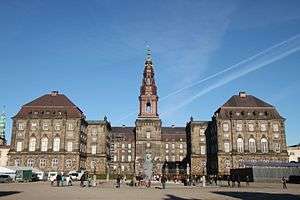
Thorvald Jørgensen (27 June 1867 - 15 May 1946) was a Danish architect, most known for his design of Christiansborg Palace, the seat of the Danish Parliament, after it had been destroyed in a fire. His other work mainly consists of churches. He was Royal Building Inspector from 1911 to 1938.
Biography
Thorval Jørgen was born on 27 June 1867 in Norsminde outside Aarhus. He completed a carpenter's apprenticeship in Aarhus in 1885 and then moved to Copenhagen where he was admitted to the Royal Danish Academy of Fine Arts the same year, where he was taught by both Hans Jørgen Holm, Martin Nyrop, Ferdinand Meldahl and Albert Jensen. He graduated in 1889, won the Academy's large gold medal in 1893 for A church with rectory, and then worked for Hans Jørgen Holm on Overformynderiet in Copenhagen from 1892 to 1893. In 1892 he received the Academy's scholarship and over the next years travelled widely in Europe, particularly in Italy.
From the turn of the century he designed a number of churches in and around Copenhagen. His design of Brorson's Church was rewarded with the Eckersberg Medal.[1]
In 1905 he won the competition for the design of the new Christiansborg Palace after Christian Frederik Hansen's previous Christiansborg Palace had been destroyed in a fire. Construction started the next year but before the building was completed in 1928 after a prolonged and difficult political process, the design had changed considerable from Jørgensen's original winning proposal. It was met with strong criticism.
In 1911 Jørgensen was appointed Royal Building Inspector. The rest of his works work mainly included churches and public buildings but also a number of villas and country houses.
Style
With influence from Holm and Nyrop, his teachers from the Academy, Jørgen belonged to the Herholdt-Holmske group of Danish Historicist architects which relied on Medieval Danish architecture for inspiration, rather than Ferdinand Meldahl's more internationally inclined followers.[2]
Later he turned to Neo-Baroque (Christiansborg Palace) and Neoclassicism (Gentofte Town Hall). Hellerup Church shows influence from Jugendstil.
Selected buildings
- Nathanael's Church, Amager, Copenhagen (1900)
- Skt Annæ Hus, 16 Sankt Annæ Plads, Copenhagen(1898)
- Brorson's Church, Copenhagen (1898–1901)
- Hellerup Church, Hellerup (1899–1900)
- Grenens Badehotel, Skagen (1899–1900, later burnt)
- 18 Kochsvej (villa), Frederiksberg, Copenhagen (1900)
- 31 Viggo Rothes Vej (villa), Charlottenlund (1901)
- Community house, St. James' Church, Østerbro, Copenhagen (1901–02)
- Brønshøj Rectory, Brønshøj, Copenhagen (1902)
- 16 Tuxens Allé (redesign of the painter Lauritx Tuxen's house, Skagen (1902)
- Isaiah Church, Malmøgade, Copenhagen (1903–12)
- Tram waiting room, Rådhuspladsen, Copenhagen (1903, moved to 43 Stokholmsvej in Mørdrup pr. Espergærde, 1948)
- Mogens Frijs' palæ (redesign), 1 Ny Kongensgade, Copenhagen (1903–04)
- Danske Sygeplejerskers Rekreationshjem, Smidstrup at Vedbæk (1904)
- Skagens Apotek, Skagen (1904)
- Free Port Church, Willemoesgade, Copenhagen (1904–05)
- Rectory, Vanløse Church, Vabløse (1905)
- Royal Library Garden, Slotsholmen (1906, with Johannes Magdahl Nielsen)
- Christiansborg Palace, Slotsholmen, Copenhagen (1906–28)
- Værnedamsvej/Gammel Kongevej (residential building), Frederiksberg (1906)
- 2-4 Trianglen (residential building), Østerbro, Copenhagen (1906)
- 6 Bukkeballevej (country house), Strandvejen, Rungsted (1907)
- Mariendal Church, Nitivej, Frederiksberg (1907–08)
- Villa Guldmaj, 10 Åkandevej, Skagen (1911)[1]
- Varde Museum, Varde (1913–14)
- Post- og Telegrafvæsenet workshops and garages, 40-44 Amager Fælledvej, Amager, Copenhagen (1919)
- Østerbros Post Office, 1 Øster Allé, Østerbro, Copenhagen (1921–22)
- Christiansborg Chapel (restoration), (1921 and 32)
- Post Giro Building (redesign of existing building) 23 Holbergsgade, Copenhagen (1923)
- Korsør Church (new spire), Korsør (1924)
- Inspectorate for Tobacco Taxation, Frederiksholms Kanal, Copenhagen (1931)
- Gentofte Town Hall, 161 Bernstorffsvej, Charlottenlund (1934–36)
- Gentofte Town Hall (lateral wing), Charlottenlund (1942–44, with Kai Rasmussen)
- Posst Giro Building, 123 Vester Voldgade, Copenhagen(1938)
- Gentofte Fire Station, Gentofte (1938 with Kai Rasmussen)
Gallery
-
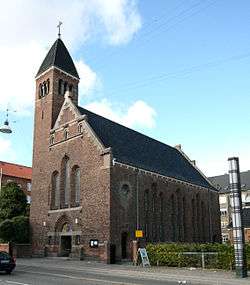
Nathaniel's Church, 1897–99
-

Brorson's Church, 1898–1901
-
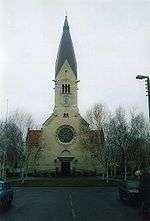
Hellerup Church, 1899–1900
-

Isaiah Church, 1903–12
-
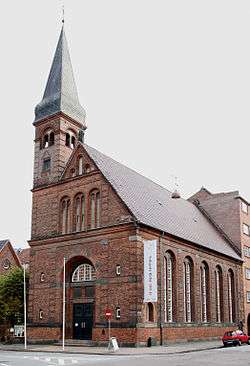
Free Port Church, 1904–05
-
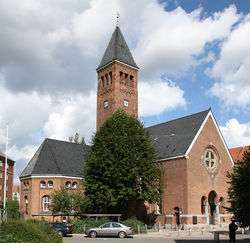
Mariendal Church, 1907–08
See also
References
- ↑ "Thorvald Jørgensen". Gyldendal. Retrieved 2011-02-15.
- ↑ "Kirkens arkitekt og kunstnere". nordiskekirker.dk. Retrieved 2011-02-15.